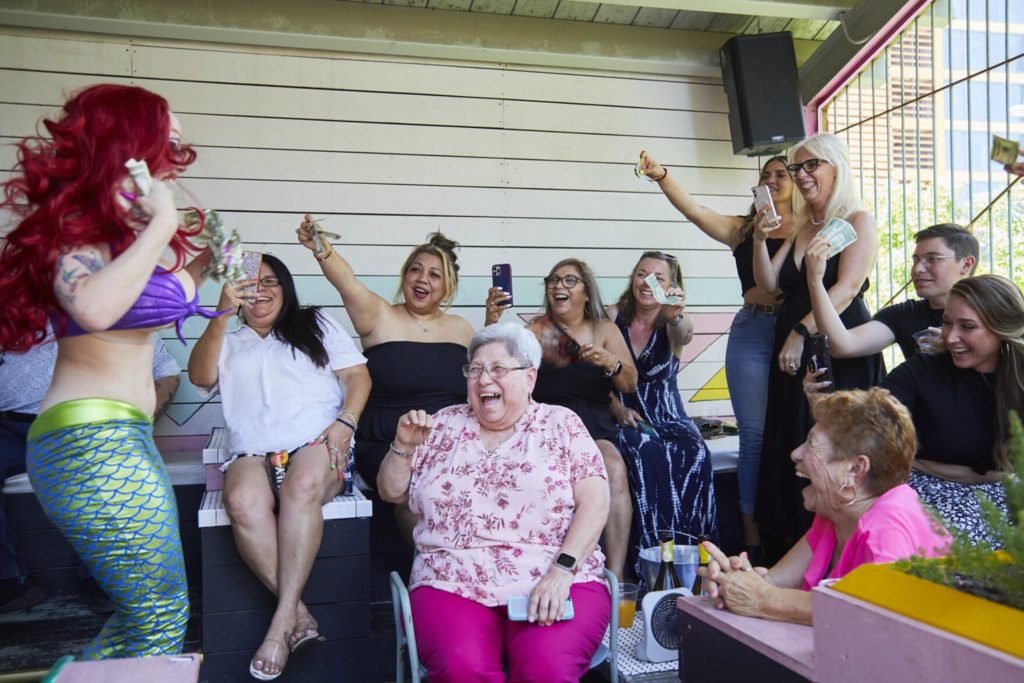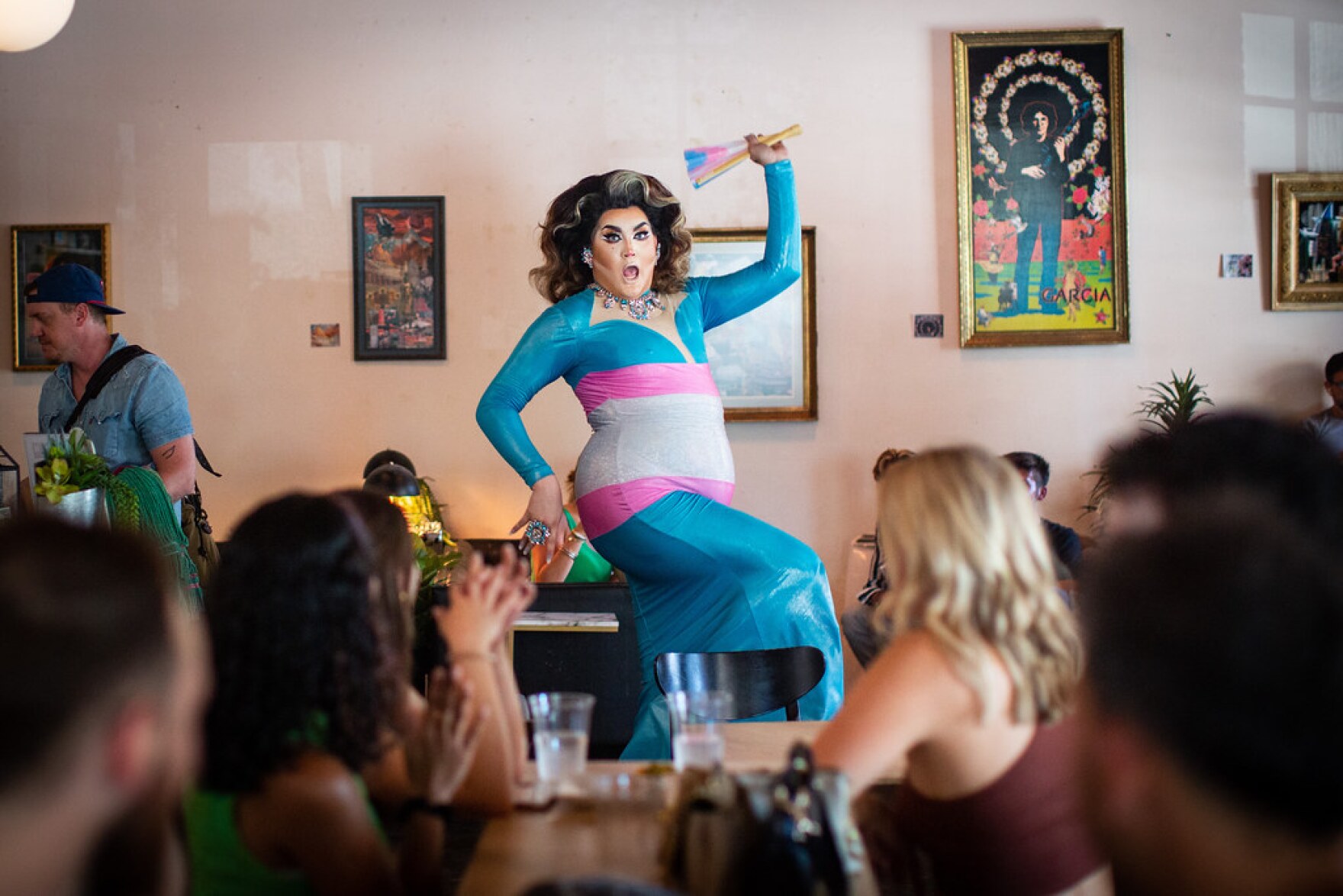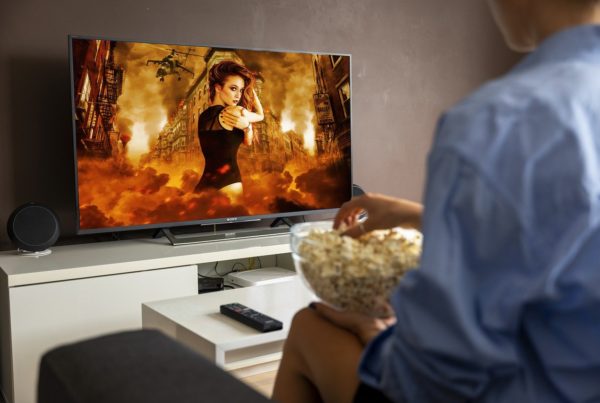From KUT:
The self-described “suspiciously large woman”‘s voice boomed across the crowded restaurant as she posed the question: “Are y’all ready to see some drag?”
Standing in her stilettos at about 6-foot-6, she wore an iridescent rainbow leotard. Her hair rivaled Dolly Parton’s both in height and color, and her makeup accentuated her cartoonishly large lashes, lips and cheeks.
Four separate tables of bachelorette parties excitedly replied: “Yassssssss!”
Maxine LaQueene moved to Austin around four years ago, excited to be a part of the city she described as “an oasis of gay.” She hosts a weekly drag brunch at Halcyon in the Fourth Street District, and performs in drag nearly every other day of the week.
A man sat in the corner on this June Saturday wearing headphones and furiously working on his laptop. Wedding parties took shots and participated in dance competitions. About a half dozen drag queens pranced and lip-synched between the tables to classic songs. The audience members were wide-eyed and glued on the performers’ exaggerated dance moves and acrobatic feats.
“It’s a very wholesome and rewarding thing to be around and to be a part of,” Maxine said. “You know, it makes you feel good. It makes you think.”
Though “RuPaul’s Drag Race” and other TV shows have popularized drag, it’s not a new style of performance art. Its roots can be traced back to ancient Greece where men played female roles in theater. The custom continued in Shakespearean performances because of the Church of England’s ban on women performing in plays. Male actors gladly grabbed the roles.
In the United States, modern drag evolved from the performances of many LGBTQ queens, including Marsha P. Johnson, a transgender woman who protested in the Stonewall riots and is often hailed as a drag icon. In the late 20th century, drag was typically done by men who dressed up and performed as women. Though these men were often gay, straight men would participate, too.
Maxine describes modern drag as an embodiment and celebration of “the divine feminine.”
“Drag is a hyperbole,” she said. “It is this exaggeration of beauty and glamor and performance art.”
Today, drag is performed by women, straight men and everyone in between.
“The idea that drag can only be a man dressed as a woman or a woman dressed as a man only reinforces the gender binary even more when drag is actually supposed to be deconstructing the gender binary,” Brigitte Bandit, a drag queen who identifies as nonbinary, said.
Family first
Traditionally, one could not simply decide to become a drag queen and begin performing in Austin. Queens had to first establish themselves in the community.
“You want to go to shows to support other girls, make yourself known and active in the community,” Brigitte said. “But to actually get booked and do shows, you have to do a drag competition.”
In Austin, Brigitte said, drag competitions — specifically competitions for “baby queens” — are held to promote the next generation of queens. Winning a baby queen competition secures your place in the drag community and will immediately help an up-and-comer secure a booking.
While breaking into the scene, baby queens often meet their “drag mothers.” A drag mother is not unlike a fairy godmother: an experienced queen with wisdom to share and the ability to make dreams come true. In pre-internet days, when drag was far more taboo, many baby queens needed to go to older figures in the community to learn how to apply body-contour makeup, hide a 5 o’clock shadow and conceal certain parts of their anatomy.
Some drag mothers have many children, and some drag families are around for generations. Your drag family is your support, answering questions and helping you get booked. It’s a more fabulous version of networking.
Supply and demand
The pandemic loosened the rigidity of many of these traditions. Austin’s drag scene exploded, Brigitte said, despite many shows being forced to cancel.
“You know, everyone was just locked in their rooms with makeup,” she said. “And now there’s a ton of drag queens everywhere.”

The audience at Coconut Club laughs during Brigitte’s performance. Brigitte says she thinks more women are enjoying drag shows these days because performers “express themselves with femininity in a way that maybe they’ve been taught is taboo.”
According to Brigitte, the demand for drag queens has increased along with the supply, especially in a place like Austin. Queens are seeing more and more interest from people who are not members of the LGBTQ community, especially straight women.
“I think women love it because they’re seeing … people express themselves with femininity in a way that maybe they’ve been taught is taboo,” Brigitte said. “I think that really strikes something within women that causes them to appreciate it the way that they do.”
Adults only?
Though drag has become more mainstream, many people still have trouble understanding what it’s all about. And misunderstanding often brings judgment and scrutiny. Recently, politicians have started calling for legislation that would bar children from attending drag shows.
When asked whether they think kids should be allowed, the queens all answered the same way for this story: It depends.
Every show is different, Maxine said, and queens tailor each performance to the expected audience. At a bar on a Friday night, she said, you can expect to “see the drag queens drinking and talking a mess and having a good time.”
Brigitte agreed certain shows should be reserved for adults.
“We do not want to see [children] at our bar at like 11 p.m.,” she said. “That’s not what anybody’s fighting for. We’re just trying to say that there are kid-friendly events that are intentionally set up for children and modified for children.”
A performance at a bar is different from a story hour hosted by a library, for example, where drag queens read books to children.
“We’re going to be like the fairytale princesses,” Maxine said. “We will be dressing up in our pretty gowns with big hair and a crown.”
Brigitte said most people who don’t think children should be around drag queens don’t understand that drag is not an inherently sexual performance.
“People that don’t realize that drag can exist outside of these, like, dark bars, which is sad, because the reason why drag exists there in the first place is because we’ve always been pushed out from society,” she said. “We’re shoved in that little box … instead of being able to be brought into the daylight, be able to be seen as people that are … not completely sexual all the time.”
Brigitte frequently does drag events for kids.
“The kids look at me like I’m a Disney princess or just something that walked out of a TV screen,” she said.
To the kids, she is a cartoon character come to life – not a sexual object. For Brigitte, femininity extends beyond that.
She said recently she has begun to be attacked on social media. When I sat down to interview her, the first thing she asked was whether I had seen her TikTok video.
In the video, Brigitte dances and lip-syncs to Katy Perry’s self-love anthem “Firework.” Three small children grin from ear to ear, singing and dancing along. A baby sitting in a highchair joins in by waving along with the big kids.
When the video reached almost 4 million views, it was removed. Brigitte appealed, but was told the removal was not a mistake; TikTok said it took it down for “child safety purposes.”
“It’s really saddened me that that’s where we’re at,” Brigitte said. “I’ve worked with kids my entire life, and now people are gonna have a problem with it? Because I have, like, a clown face on? It’s just so strange to me. And it was really hard that that happened.”
The video is still up on Facebook and Instagram, and amid the hateful comments, Brigitte’s also received comments of encouragement — and 50,000 new followers.
“I found a ton of people who were very supportive and genuinely want to learn and know more,” she said. “And so, I’ll just keep doing that and explaining and teaching people and just being present, and I don’t know, being representative of my community.”
At her Halcyon drag brunch, Maxine also tries to connect with and educate people while entertaining them.
“It is important to realize that through the art that we portray, we are allowing ourselves to be vulnerable,” she said. “And for people to come in and witness that vulnerability, they can see that we’re human, too.”












